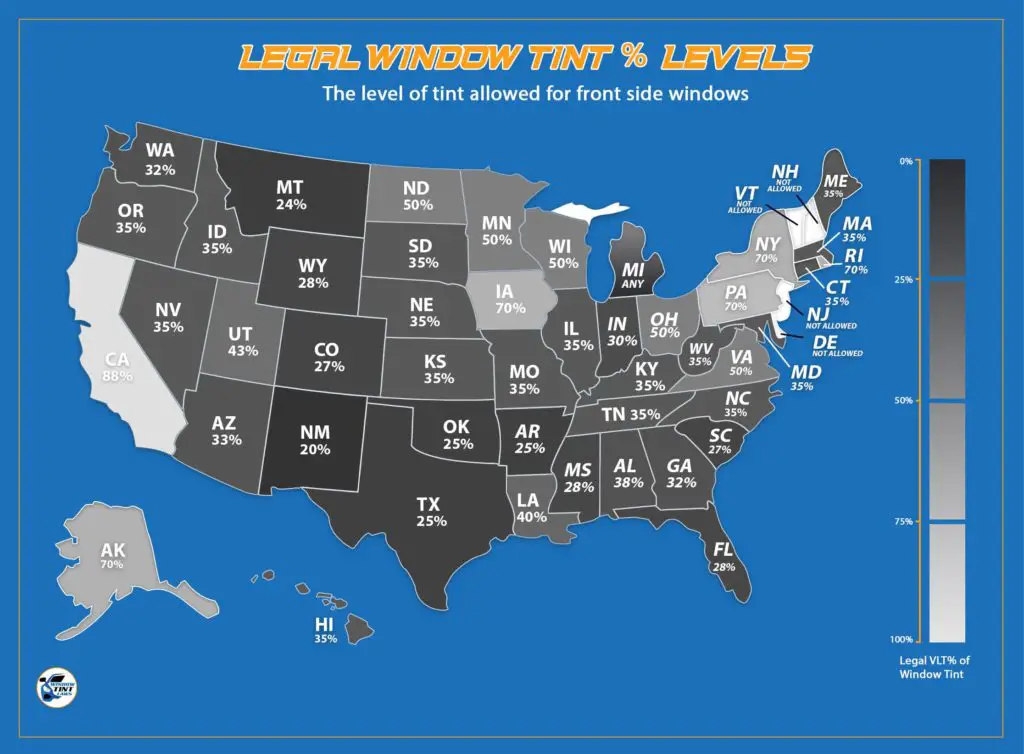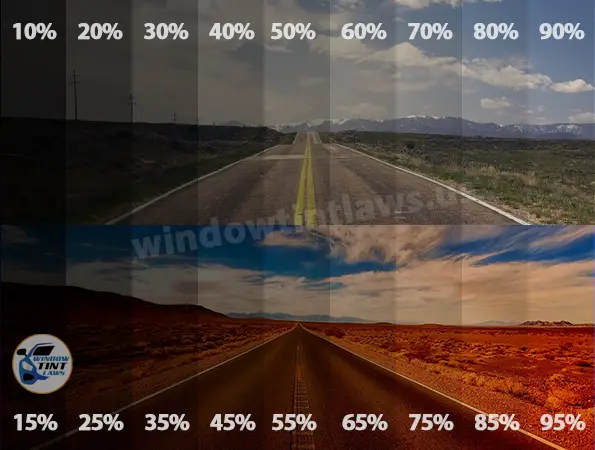Last Updated on August 23, 2022 by
From privacy to blocking out heat, there are a lot of good reasons to tint the windows of your car. However, it’s important to make sure you’re abiding by the law and not putting yourself in danger with your tint, which means getting the right shade. Fortunately, our window tint percentages guide makes it easy to get the perfect tint for your car.
What Is VLT?
Visible light transmission (VLT) is the most important metric to focus on when it comes to tint darkness. When people refer to “5% tint” or “20% tint,” they’re talking about the VLT level. So, what exactly does the VLT of window tint tell you?
The VLT of a tint describes how much light a window film allows to pass through, although it is a bit confusing. While you might think a higher VLT would indicate darker, more effective tint, the opposite is actually the case. Whatever the VLT level of a tint is, that’s the percentage of light that’s allowed through the tint. For example, 5% tint only allows 5% of light to pass through while 35% tint allows 35% of light to pass through.
While VLT isn’t the only thing you need to consider if you want the best tint, it’s a good start.
Lower VLT window tint will generally provide you with better UV protection, which helps keep your interior in good shape and keep your car cooler. Blocking out these UV rays is also an important part of eye and skin health.
VLT is also a big factor in whether or not your tint is legal. Every state has its own tint laws, with some counties and cities also regulating tint darkness. Before you purchase and install window tint, make sure you know what VLT is legal in your state, city, or county.
Window Tint Preview Tool
Want to see a real-life example of a specific tint percentage?
We have done our best to put together a realistic Window tint percentage previewer for you and hope you find it valuable!
Reflectivity
While VLT is the most commonly used metric for determining whether or not window tint is legal, it’s not the only factor. In most states, there are also laws regarding the reflectivity of your window tint. While some darker window tints don’t reflect a lot of light, some tints are made from a reflective material that can add even more privacy.
If you’re looking for a privacy window tint, reflective tint is a good option. However, many states have strict limits when it comes to reflectivity. When you buy tint, you should look at the reflectivity to make sure it meets the legal limit in your state or county. As is the case with VLT, this reflectivity will be displayed in a percentage, with many states setting the limit at 20%.
In some states, you aren’t allowed to use reflective tint at all. This includes both metallic and mirrored tinting in most cases, both of which tend to have a mirror-like effect. Instead, you’ll have to use plain old black tint that’s within the legal window tint levels for your state.
It’s important to mention that reflectivity is more about privacy than UV protection. While a reflective window film may add a little more protection from the sun and heat, you can still get excellent UV protection from some of the plain black window films on the market. And with the darkest window tint you can legally use in your state, you shouldn’t have to worry too much about privacy anyway.
Tint Laws
Every state in the United States has laws when it comes to tinting your windows. These laws tell you what type of tint you’re legally allowed to use, but it’s not as simple as buying a window film kit with the right VLT.
For starters, most states allow different window tint levels for different windows. While you may be able to tint window with 35% tint, another window may require 40% tint. Conversely, it could be the case that some windows have no restrictions in terms of VLT level. Sometimes it’s best to buy a few different window tint percentages so you can mix and match.
Reflectivity also comes into play when it comes to tinting your windows legally. There are many different types of window tint, some of which are very reflective. In some states, you aren’t allowed to use reflective tints or tints with a certain amount of reflectivity.
While this isn’t the case everywhere, there are some additional restrictions in some states. For example, there may be certain requirements if you tint your back window or you may not be allowed to use certain colors of tint at all. Make sure you understand these laws in addition to the legal window tint levels for VLT and reflectivity.
Tinting Your Windshield
When it comes to tinting the windows on your car, the windshield is probably the trickiest part. Not only do windshields have different tinting laws in different states, but most states only allow you to tint a small portion of your windshield. However, there are some states that don’t allow you to tint your windshield at all.
If you are allowed to tint your windshield in your state, you’ll be restricted to tinting the top portion of the windshield. The amount of windshield you can tint varies from state to state, although it’s usually about 4 to 6 inches. In lieu of a number of inches you can tint, your state may allow you to tint to the AS-1 line. Every automotive windshield has the letters “AS-1” on it; some states allow you to tint to the line where the letters “AS-1” are found.
There are some exceptions when it comes to state windshield tinting laws. While there are only a couple states that don’t tell you how much of your windshield you can tint, they do exist. In the states where you can tint your entire windshield, however, you’re only allowed to use tint with a VLT of 70% or higher.
Tinting Your Front Side Windows
As far as window tint restrictions go, your front side windows are on the stricter side of things.
While you can tint your front side windows in almost every state, this is usually the second lightest shade of tint you’re going to use on your car. The reasoning behind this is that lighter tint in the front window allows the driver to see better while driving.
For the most part, you’ll have to keep your front side window tint pretty light. Many states have a limit of 35%, with some states going as low as 20% and others going as high as 70%.
The states that get more sunlight are generally the ones that allow darker tint while states that get less sun tend to have stricter tint laws.
There are some states where you simply aren’t allowed to tint your front side windows. Even though these states are strict about front side window tint, some of them allow you to use the darkest window tint on the market when it comes to your rear side windows.

Tinting Your Rear Side Windows
As far as tinting windows goes, it doesn’t get much better than your rear side windows.
Of all the windows on your car, these are the ones that are least important in terms of vision. This is why most states allow you to tint your rear side windows with much darker tint than you’d use for a windshield, rear window or front side window. In some states, there really are no restrictions.
A good portion of states allow you to tint your rear side windows as dark as you want.
Literally, many states have absolutely no regulations as far as VLT levels go for rear-side windows. If you want that 5% limo tint look on your car, the rear side windows are the best place to do it.
It’s important to keep in mind that not all states allow you to tint your rear side windows as dark as you want. As a matter of fact, there are plenty of states that only allow you to tint your rear windows to around 30%.
You also need to make sure you’re abiding by any color and reflectiveness laws that may be in effect.
If you’re planning on tinting your rear windows to the darkest legal tint level, make sure you buy two separate window tint kits.
After all, you’re not going to be able to use that same 5% tint on your front side windows.
Tinting Your Rear Window
As is the case with the windshield, tinting your rear window isn’t the simplest process. Your rear window allows you to see what’s going on behind you when you’re on the road. If you tint your rear window too dark, you’ll end up having to rely on your side mirrors. This is why most states don’t allow you to tint your rear window very dark.
While most states are pretty conservative when it comes to rear window tint darkness, there are actually some states that allow you to tint your rear window as dark as you want.
The only thing you have to keep in mind is that many of the states that allow you to use any tint darkness level on your window will require you to have dual side mirrors as a substitute for your window.
Many of the states that have tint darkness laws for rear windshields have a limit of around 30 or 35%. There are some states that have a limit as low as 10% as well as others with a limit as high as 50%.
Still, some of these states require you to have dual side mirrors even if you’re only using 35% tint on your rear window.
Interestingly enough, there are no states that don’t allow you to tint your rear window. No matter where you live, you can put some level of tint on your rear windshield and still drive legally.
Dark Tint vs. Light Tint
While dark tint might seem like the best choice, it’s important to understand the pros and cons of both dark and light tint.
Dark tint is the most common type of window tint, with shades ranging from black and blue to red and green. As dark tint starts to fade, it often takes on a sort of purple color.
The big benefit to dark tint is that it’s effective in terms of blocking out sunlight and keeping your car cool. However, the color of this tint can also make it difficult to see in and out of your windshield. While this is a big benefit when you’ve got your car parked on the side of a busy street, it can cause problems when you’re driving. Still, dark tint is a great option if you’re looking to block out some sunlight and protect your interior.
Light tint isn’t nearly as common as dark tint, but there are still tons of options available.
Light tint generally comes in colors that are closer to transparent, such as a light blue or even a yellow. Most people use light tint because it allows them to see out of their windows better.
The best part is, there are lighter tints that have a fairly high VLT level, which means they still block out a lot of sunlight and help protect your interior. The biggest downside to light window tint is that it simply doesn’t provide the same type of privacy as dark tint.

What is 0% Tint?
The darkest of all the window tints is 0%, also known as blackout tint. Blackout tint allows 0% of sunlight into your car, giving you some of the best UV protection, heat reduction and privacy. Unfortunately, most states don’t allow blackout tint because it can reduce visibility so much. While there are states where you can legally use blackout tint, it’s simply too dark for many people.
What Is 5% Tint?
One of the most common VLT levels for dark tint is 5%. 5% tint is also known as limo tint because of the excellent privacy it provides. Since 5% tint blocks out 95% of light, it’s also great for UV protection and keeping your car cool. The only problem with 5% tint is that it’s not legal to use in a lot of states, especially when it comes to the rear windshield and front side windows.
What Is 10% Tint
If you’re not allowed to use 5% tint in your state, 10% is the next darkest tint level you can buy. While 10% tint is still very dark, it’s a big step down from limo tint in terms of visibility in and out of the car. Just like limo tint, 5% tint generally comes in a dark black color which does a great job of giving you privacy and protecting your interior from sun damage.
What Is 20% Tint
20% tint is the first VLT level you’ll see that’s legal on various types of windows in a lot of different states. While 20% tint may not be as common as 35% in terms of legally tinting your windows, it’s an excellent choice for rear-side windows if you want to darken things up a bit. In some states, you can even use 20% tint on your front side windows.
What Is 35% Tint
If you want to guarantee you’re doing things by the book, 35% tint is the best way to go. While it may not be the darkest tint available, 35% strikes a great balance of blocking out the sunlight without making it too hard to see through your windows. Plus, you can find 35% tint in various different shades to match your car.
What Is 40% Tint
As you go beyond 35% tint, you get into the range of very light tints, many of which are used for things like windshields and rear windows. However, there are actually a few states that limit the VLT level at 40%. Whether it’s required in your state or you’re just looking for a more subtle way to tint your windows, 40% is a good choice. Just remember to look for a quality film that’s designed to block out heat.
What Is 50% Tint
50% tint is one of the least used VLT levels on the market. Not only is 50% tint not very dark, there aren’t a lot of states that set their VLT limit at 50. Unless your state doesn’t allow you to go below 50% or you don’t want to sacrifice visibility for privacy and UV protection, there’s no real reason to go for 50% tint.
What Is 70% Tint
Tinting your side windows is fairly simple, but windshields and rear windows are a different case. If you want to safely and legally tint non-side windows, 70% tint is your best bet. It’s important to note that there are plenty of states that don’t allow you to tint your entire windshield. On top of that, some states require dual side mirrors in lieu of a non-tinted window. In general, however, you don’t have anything to worry about when installing 70% tint.
